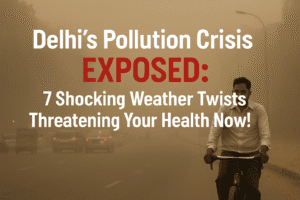Delhi’s Pollution Crisis EXPOSED: 7 Shocking Weather Twists Threatening Your Health Now!
Delhi faced extreme weather whiplash as temperatures hit 42.3°C, two degrees above normal, before thunderstorms and gusty winds (40–50 kmph) brought localized rain, offering fleeting relief. Despite this, air quality remained “poor” (AQI 278), prompting authorities to enforce Stage 1 of anti-pollution measures (GRAP) to curb dust and emissions. Hazardous PM10 levels spiked to 8x the safe limit in areas like Wazirpur, driven by winds carrying dust from Rajasthan and Pakistan.
The sudden storms, triggered by a convective weather system, failed to mitigate pollution, with experts warning of respiratory risks for vulnerable groups. Simultaneously, peak power demand soared to 6,867 MW, reflecting strain on infrastructure amid heat stress. While forecasts predict cooler temperatures (25–38°C) and rain by May 22, “poor” AQI levels are expected to persist, underscoring Delhi’s dual climate and pollution crisis. Long-term solutions, including greener policies and stricter emission controls, remain critical to breaking the cycle of environmental emergencies.

Delhi’s Pollution Crisis EXPOSED: 7 Shocking Weather Twists Threatening Your Health Now!
Delhi residents faced a stark contrast in weather conditions this week as sweltering heat collided with sudden thunderstorms. Temperatures soared to 42.3°C, nearly two degrees above average, before evening storms brought gusty winds (40–50 kmph) and localized rain. While Safdarjung recorded 1.4 mm rainfall, areas like Ayanagar saw up to 7.2 mm, offering fleeting relief from the heat but failing to mitigate the city’s worsening air quality.
Pollution Emergency: Stage 1 GRAP Activated
With the Air Quality Index (AQI) lingering in the ‘poor’ category (278 on Friday), the Commission for Air Quality Management (CAQM) enforced Stage 1 of the Graded Response Action Plan (GRAP). This measure—triggered when AQI remains ‘poor’ for 48+ hours—includes stricter enforcement of dust control at construction sites, waste management, and penalties for open burning. Despite initial hopes that winds would disperse pollutants, variable wind patterns instead carried dust from Rajasthan and Pakistan, exacerbating particulate levels.
Meteorological Whiplash: From Dust Storms to Thunderstorms
The abrupt shift from dusty heat to rain was driven by a convective system—a localized weather phenomenon where warm, moist air rises rapidly, forming storm clouds. Originating in Rohtak, this system swept into Delhi-NCR, unleashing thunderstorms. While such systems typically bring short-lived relief, they also highlight the region’s vulnerability to erratic weather linked to broader climatic shifts.
Air Quality Breakdown: Hotspots and Health Risks
Pollution data painted a grim picture:
- Wazirpur recorded PM10 levels at 847 µg/m³ (8x the safe limit) and PM2.5 at 248 µg/m³ (4x the limit).
- Anand Vihar, Rohini, and Bawana also saw PM10 exceeding 500 µg/m³.
These levels pose severe respiratory risks, particularly for vulnerable groups. Experts urge residents to limit outdoor activities and use masks, especially during morning/evening peaks when pollution concentrates.
Beyond Weather: Surging Power Demand and Infrastructure Strain
Friday’s heat spike pushed Delhi’s power demand to a summer high of 6,867 MW, underscoring the strain on energy infrastructure. While cloudy skies may lower temperatures temporarily, the incident reveals the city’s precarious balance between climate extremes and resource management.
Forecast and Preparedness
The IMD predicts gradual cooling, with temperatures dipping to 25–38°C by May 22, accompanied by possible rain. However, ‘poor’ AQI levels are expected to persist until Sunday, demanding sustained adherence to GRAP measures. Authorities are monitoring construction and traffic emissions, while residents are advised to stay alert for sudden storms, which may cause tree falls or power disruptions.
The Human Impact: Navigating a Dual Crisis
For Delhi’s 32 million residents, the dual challenges of extreme heat and pollution require adaptive strategies:
- Health vigilance: Increased cases of asthma and allergies are reported during such spikes.
- Energy conservation: Public awareness campaigns promote reducing AC usage during peak hours.
- Community action: Local groups are advocating for greener spaces and waste reduction to curb dust and emissions.
Looking Ahead
While GRAP Stage 1 offers a regulatory framework, long-term solutions demand systemic changes—transitioning to renewable energy, expanding public transport, and enforcing stringent industrial norms. As climate volatility becomes the norm, Delhi’s resilience hinges on proactive governance and community engagement. For now, the city remains a microcosm of the global urban climate crisis, where weather extremes and pollution converge, testing the limits of adaptation.
You must be logged in to post a comment.